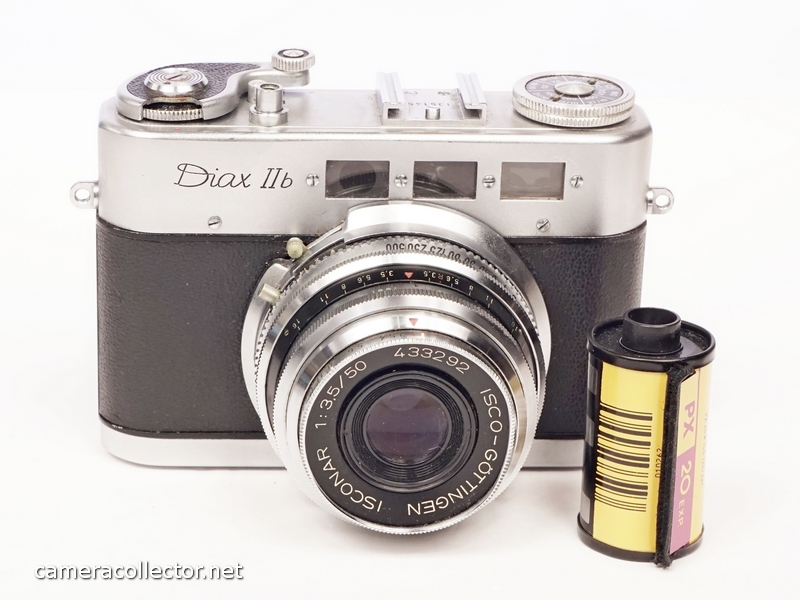Voss Diax IIb
Voss Diax IIb
I thought I am done with the Diax models, as described on the Voss Diax page. Not so; I came across a Diax IIb in immaculate condition, which I couldn’t resist buying. The Diax brand existed for a short decade, and although it made well-built cameras, I guess they could not compete with the leaders for a place at the top end of the price pyramid.
The Diax models are confusing, slightly evolving from one model to another:
| Model | Year | Type | Winder | |
| Diax Standard | 1949 & 1951 | Viewfinder | Knob | |
| Diax Ia | 1952 | Viewfinder | Knob | Three different finders |
| Diax Ib | 1956 | Viewfinder | Lever | As the Ia |
| Diax II | 1951 | Rangefinder | Knob | As the early Diax with a rangefinder |
| Diax IIa | 1954 | Rangefinder | Knob | |
| Diax IIb | 1956 | Rangefinder | Lever |
The first model, the Diax Standard, had a fixed lens. The I and II cameras had interchangeable lenses mounted via an M55 thread, male on the body and female on the lens. There were eight different lenses, a tall order for a budding camera maker.
The commonality to the late models is the integrated viewers. Whereas other camera makers using interchangeable lenses offered accessory finders, Diax had an integral viewer for different focal length lenses. The IIb on my desk has a viewer for 50mm and a second for 85-90mm lenses. An add-on Tele viewer was offered as well. For a close-up, Diax offered a Proximeter add-on mask; see more on the Diax page. Note that the rangefinder models shared the focusing patch for both viewer windows. The Diax Ia and Ib look like a rangefinder, having three front windows, but each has a matching window at the back for 50, 35 and 90mm lenses.
The factory converted some of the knob-wielding cameras to levers, which is immaterial to collectors. It can be noticed in a mix of serial numbers that look out of sequence.
As with the rest of the Diax models, the camera on my desk is a state-of-the-art apparatus and is immaculately finished. It is 68 years old, but it looks and feels like it was made today. All mechanical functions hum and buzz as they should, the glass is clean and clear, and the body and skin are faultless. Operating the camera is straightforward, with no tricks or mystery levers. It has all that a 1950s photographer could ask for, at a Leitz quality but at a modest price. It is a pity the brand did not last longer, but considering that of the dozens of post-war German camera makers, only a handful still exist, fate was inevitable.
For the collector, the Diax cameras are a sterling example of post-war ingenuity and craftsmanship. Either for use or to grace the shelf, it is a valued item to have.
| Camdex list number | 3308 |
| Brand | Voss |
| Model | Diax IIa |
| Manual | Butkus |
| Value | At camdex.ca |
| Format | 35mm |
| Introduced | 1954 |
| AKA | |
| Country | Germany |
| Qty made | |
| Initial price | 264 |
| Currency | DM |
| Type | Rangefinder |
| Body material | Metal |
| Mode | Manual |
| Weight | 460 gr, Body only |
| Class average weight | 480 gr, Body only |
| ASA range | N/A |
| Kit lens | 2.8/45 |
| Lens make | Xenar |
| Filter size | 40.5mm |
| Lens mount | Thread |
| Mount size | 55mm |
| Aperture | |
| Shutter | Leaf |
| Shutter make | Synchro Compur |
| Trigger | On top |
| Winder | Knob |
| Shutter_cocking | Winder |
| Light meter | None |
| Lock | No |
| Speeds | B, 1-500 |
| Mirror | N/A |
| Viewer | Viewfinder, 3 windows |
| DOF preview | No |
| Exposure lock | No |
| Exposure compensation | No |
| Shoe | Cold |
| External sync | X/M |
| Timer | No |
| Battery, original | N/A |
| Sync speed | |
| Battery, replacement | N/A |
| Battery voltage | N/A |
| Integral flash | None |
| Other | |
| More | Diax page |
| Service / repair links | See camerlog.com |
















